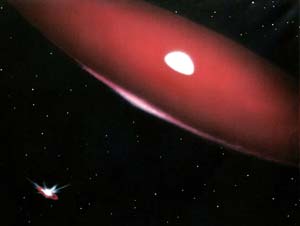This area deals with the fundamental laws and building blocks of nature and how they interact, the properties and the behavior of matter, and research into space and time and their structures.
innovations-report provides in-depth reports and articles on subjects such as astrophysics, laser technologies, nuclear, quantum, particle and solid-state physics, nanotechnologies, planetary research and findings (Mars, Venus) and developments related to the Hubble Telescope.

The research team of the Public University of Navarre (Basque Country), under the supervision of professor Ramon Gonzalo Garcia of the department of Electric and Electronic Engineering, is participating in a project of the European Space Agency. The final objective is the design of a camera that, working in the range of millimetric frequencies, will be able to obtain images send by different bodies, for example, stars.
The project named “Photonic antenna front-ends: Photonic crystals: Mater

Just as matter can be converted into energy, so too can energy become matter. That’s what five-dozen Jefferson Lab researchers were counting on for an experiment in Hall A
Albert Einstein figured it out by 1905, as he was formulating his special theory of relativity: while you can’t exactly get something from nothing, you can come close. His famous formula, E=MC 2 , works both ways. Just as matter can be converted into energy, so too can energy become matter.
That’s

Astronomers have been puzzled for decades as to how the rings of hot gas surrounding certain types of star are formed. Now a team of scientists from the Universities of Glasgow and Wisconsin believe they have found the answer. The team studied a type of young, hot star, known as a “Be star”, that has a disk of glowing gas around it, similar to the rings surrounding Saturn. Until now, no one has been able to account for how these rings form but in a paper published this month*, the team suggest an ans

Using a technique based on the work of the 1902 Nobel Prizewinner, Pieter Zeeman, an international team of astronomers have, for the first time, provided conclusive proof that the magnetic field close to a number of aging stars is 10 to 100 times stronger than that of our own Sun. These observations suggest a solution to the long outstanding problem as to how, at the end of their lives, a perfectly spherical star can give rise to the complex and often far from spherical structure seen in the resultin

VLT UVES Observes Most Metal-Deficient Star Known [1]
A faint star in the southern Milky Way, designated HE 0107-5240, has been found to consist virtually only of hydrogen and helium. It has the lowest abundance of heavier elements ever observed, only 1/200,000 of that of the Sun – 20 times less than the previous record-holding star.
This is the result of a major ongoing research project by an international team of astronomers [2] . It is based on a decade-lon

Researchers have found that a portion of anomalous cosmic rays — charged particles accelerated to enormous energies by the solar wind — results from interactions with dust grains from a belt of comet-sized objects near Pluto’s orbit. These objects make up what is known as the Kuiper Belt, a remnant of the formation of the solar system.
“This novel finding shows how dust in the cosmos may play an important role for producing the most energetic particles known,” says Dr. Nathan S